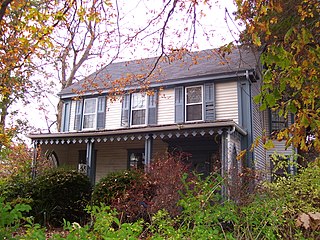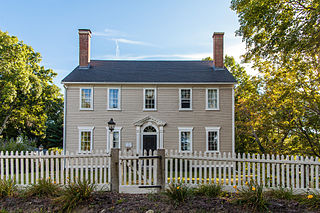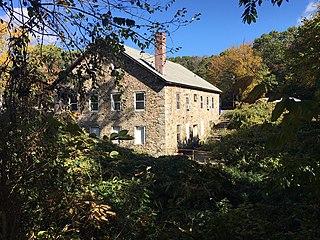
College Hill is a historic neighborhood of Providence, Rhode Island, and one of six neighborhoods comprising the city's East Side. It is roughly bounded by South and North Main Street to the west, Power Street to the south, Governor Street and Arlington Avenue to the east and Olney Street to the north. The neighborhood's primary commercial area extends along Thayer Street, a strip frequented by students in the Providence area.

Veterans Memorial Auditorium is a performing arts theater in Providence, Rhode Island. Construction began in 1928 but was delayed by the Great Depression. The theater was finally completed in 1950. The adjacent Performing Arts Complex was erected in 1970 and is partially owned by the Veterans' Memorial Foundation.

The Esek Hopkins House is an historic home on 97 Admiral Street on the north side of Providence, Rhode Island, United States.

The Bird's Nest is a historic house at 526 Broadway at the One Mile Corner junction in Newport, Rhode Island, not far from the city line with Middletown. It is a 2+1⁄2-story wood-frame structure, three bays wide and two deep, with a gable roof and a large central chimney. A two-story ell extends from the rear of the house, and there are smaller additions which further enlarge the house by small amounts. An early 20th-century garage stands behind the house. The oldest portion of the house is estimated to have been built between 1725 and 1750, with most of the alterations coming in the 19th century, giving the house a vernacular mix of Federal, Greek Revival, and Gothic Revival elements. It was given its name by Dr. Rowland Hazard, who bought the property in the 1840s and used it as a summer retreat.

The Dr. Charles Cotton House is an historic house at 5 Cotton Court in Newport, Rhode Island. It is one of the city's oldest houses.

The Angell–Ballou House is an historic house at 49 Ridge Road in Smithfield, Rhode Island, United States. The 2+1⁄2-story wood-frame structure was built c. 1800 for Jonathan Angell, a farmer and wheelwright. It is a well-preserved example of Federal style, with some high-quality woodwork and design elements more typical of Federal-style houses in sophisticated urban settings, but also showing some vernacular departures from the style. The house was sold in 1854 to Peter Ballou, in whose family it remained well into the 20th century.

The Israel Arnold House is an historic house on Great Road in Lincoln, Rhode Island. It is a 2+1⁄2-story wood-frame structure, set on a hillside lot on the south side of Great Road. The main block is five bays wide, with a central chimney rising through the gable roof. A 1+1⁄2-story gambrel-roofed ell extends to one side. The ell is the oldest portion of the house, built c. 1720 by someone named Olney. The main block was built c. 1760. The house was owned into the 20th century by four generations of individuals named Israel Arnold.

The Cornell—Randall—Bailey Roadhouse is an historic building located at 2737 Hartford Avenue in western Johnston, Rhode Island. The oldest portion of this 2+1⁄2-story wood-frame structure was built in the late 18th century by Samuel Steere, and was substantially enlarged for use as a tavern in 1821 by Daniel Cornell. Business at the tavern declined when railroads rendered the highway less important, and the building was adapted for use as a bordello and gambling house in the early 20th century. In the 1970s it was converted for use as a gift shop.

The Elliot–Harris–Miner House is an historic house located at 1406 Old Louisquisset Pike in Lincoln, Rhode Island. It is a rambling three-section structure, whose main block is 2-1/2 stories tall with a cross-gable roof with bracketed eaves. The oldest portion of the house, however, was at its rear: it was originally a 1-1/2 story Cape style structure built c. 1710, but this has been torn down and replaced by a garage with a cross-gable roof matching that of the main block. These two sections are joined by a third section with a gable roof. The rear section was believed to be the oldest surviving Cape in Lincoln.

The Edwin H. Farnum House is an historic house at the junction of Putnam Pike and Collins Street in Johnston, Rhode Island. It is a two-story wood-frame structure, five bays wide, with a large central chimney. It was built c. 1765, either by Stephen Angell or his son Daniel, and enlarged about 1795 by Edwin Farnum. The main entry exhibits Federal styling probably added by Farnum, with 3/4 length sidelight windows and a segmented fanlight above. The right-side bays on the first floor have been replaced by a 20th-century bay window.

The Joseph Smith House is a historic house at 109 Smithfield Road in North Providence, Rhode Island, United States. It is a 2½-story wood-frame house, six bays wide, with a shed-style addition to the rear giving it a saltbox appearance. The oldest portion of this house, built around 1705, is a classical Rhode Island stone-ender house, whose large chimney has since been completely enclosed in the structure. The lower levels of this chimney are believed to predate King Philip's War (1675–76), when the previous house was burned. The 1705 house was built by Joseph Smith, grandson of John Smith, one of Rhode Island's first settlers. It was greatly enlarged in 1762 by Daniel Jenckes, a judge from a prominent Rhode Island family, for his son, and was for many years in the hands of Jenckes' descendants. The house is the only known surviving stone-ender in North Providence.

The Whipple–Angell–Bennett House is an historic house at 157 Olney Avenue in North Providence, Rhode Island. It is a 1+1⁄2-story gambrel-roofed wood-frame structure, four bays wide, with a series of additions extending it to the north and east. Built in 1766, it is one of only two surviving gambrel-roofed 18th-century houses in North Providence. Its additions exhibit the adaptive reuse of and changes in vernacular style in the 19th and early 20th centuries. The interior of the house has retained a great deal of integrity, with original woodwork, plasterwork, and door hardware.

The Allen–Madison House is a historic house on Marine Road in North Kingstown, Rhode Island. It is located on the grounds of the former Davisville Naval Construction Battalion Center, set on an isolated plot apart from the main portion of the base.

The Wayland Historic District is a predominantly residential historic district on the east side of Providence, Rhode Island. It is a large area, covering about 122 acres (49 ha), bounded roughly on the north by Everett and Laurel Avenues, on the east by Blackstone Boulevard and Butler Avenue, on the west by Arlington Avenue, and on the south by Angell and South Angell Streets. This area, which was in the 19th century part of the Moses Brown farm, was platted for development in 1891, with most of the construction taking place in the early decades of the 20th century. Most of the residential properties in the district are single-family houses, typically built in revival styles popular at the time. They are set on similarly-sized lots with fairly uniform setbacks, and were typically built without garages. There are a number of two-family houses, and a small number of apartment buildings, most of which are found on the arterial roads of the area. There are several religious buildings, including several churches; the most architecturally distinctive religious building is the Jewish Temple Beth El, built 1951–54.

The Babcock House is a historic house also known as Whistling Chimneys, located on Main Street in the Quonochontaug section of Charlestown, Rhode Island.

The Joseph Jeffrey House is an historic house on Old Mill Road in Charlestown, Rhode Island. It is located on the east side of Old Mill Road, just south of Saw Mill Pond and Sawmill Brook, on a predominantly wooded 9.5-acre (3.8 ha) lot. The main house is a 1+1⁄2-story wood-frame structure with a gambrel roof and central chimney, with a small gable-roof ell to the northeast. The oldest portion of the main block appears to be the easterly side, which rests on an old stone foundation, and exhibits construction methods typical of the second quarter of the 18th century. The house was probably built by Joseph Jeffrey, a Narragansett, on land granted to him by the tribe, whose advisory council he sat on.

The Palmer–Northrup House is an historic house at 7919 Post Road in North Kingstown, Rhode Island. It is a 2+1⁄2-story wood-frame structure, and is one of a small number of surviving stone ender houses in the state. Its architecture suggests it was built in the 17th century, either around the time of King Philip's War (1675–78) or possibly even earlier. The oldest portion of the house, including its massive fieldstone chimney, are relatively intact despite later additions around 1740 that significantly enlarged the house. The house stands across the street from Smith's Castle, a house of similar vintage which was built on the site of a trading post established by Roger Williams in 1637.

The Sheffield House is an historic house on Beach Road in the Quonochontaug section of Charlestown, Washington County, Rhode Island. It is a 1+1⁄2-story, wood-shingled, gambrel-roofed residence, with a large, stone chimney; a simple entry at the left side of a 3-bay, south-facing façade; and a 1-story wing at the left side. The house was probably built between 1685 and 1713, probably by Joseph Stanton (1646-1713), the third son of Thomas Stanton (1616-1677), one of the original settlers in this area. Joseph's son Thomas, had no surviving sons, so the farm was deeded in 1753 to his son-in-law Nathaniel Sheffield (1712-1790) the husband of Rebecca Stanton (1713-1775). Today the house is called the Stanton-Sheffield house.

The U.S. Customshouse is a historic custom house at 24 Weybosset Street in Providence, Rhode Island at the northeast corner at Weybosset and Custom House streets. The customhouse was built between 1855 and 1857 to a design by Ammi B. Young and added to the National Register of Historic Places in 1972. In 1992, the building was purchased by the State of Rhode Island and converted to office space for the State Courts System. The building was opened by the state of Rhode Island as the John E. Fogarty Judicial Complex after an extensive $550,000 renovation.

The Otis Angell Gristmill is a historic mill in Governor John Notte Memorial Park, North Providence, Rhode Island. Built about 1855, it is a well-preserved example of a small 19th-century industrial site, with a stone mill building and a small mill pond. The site was added to the National Register of Historic Places in 2017. The mill building now serves as a local community center.






















